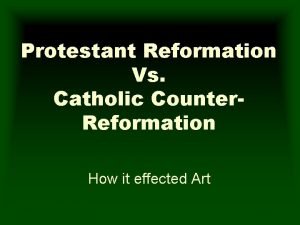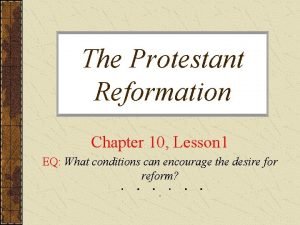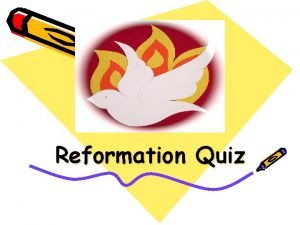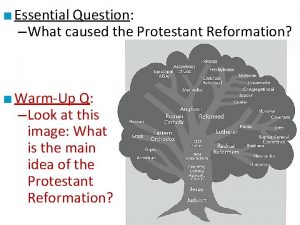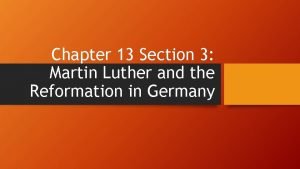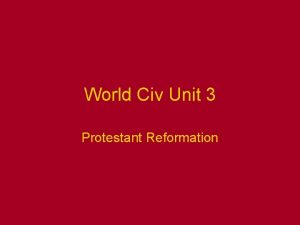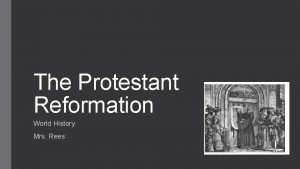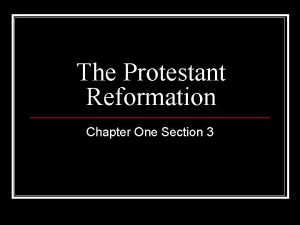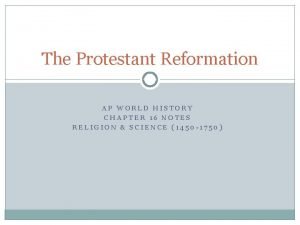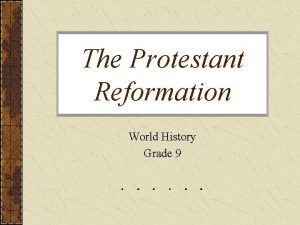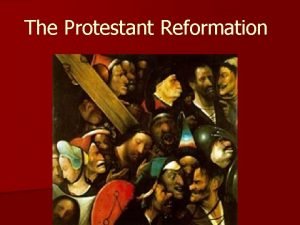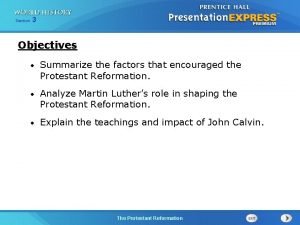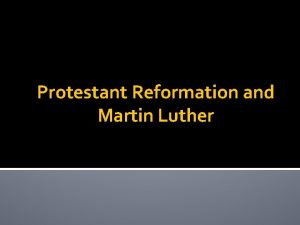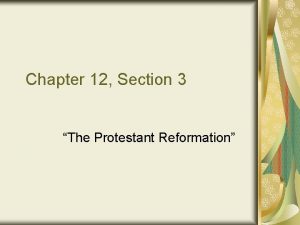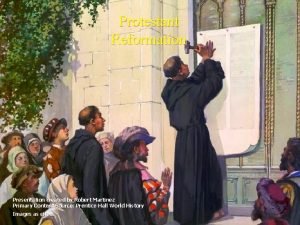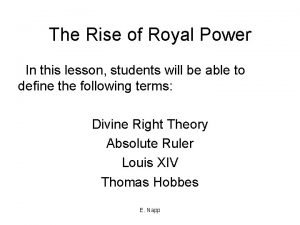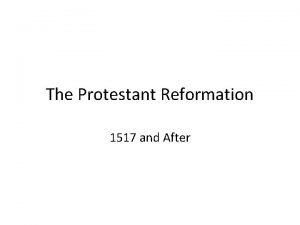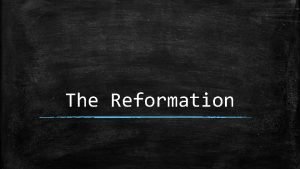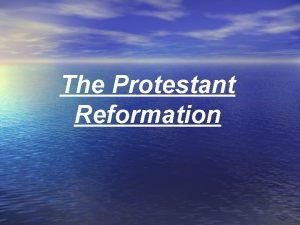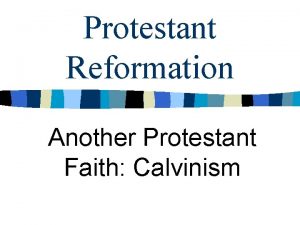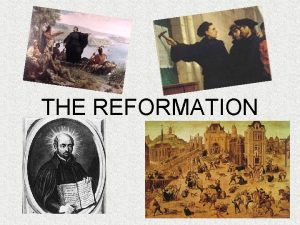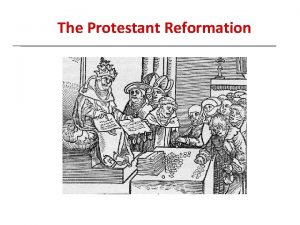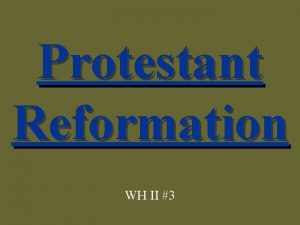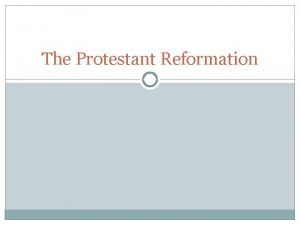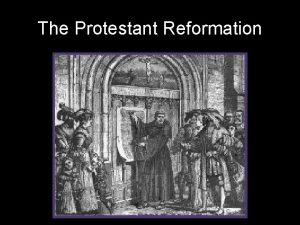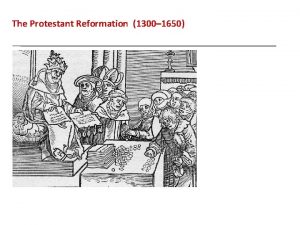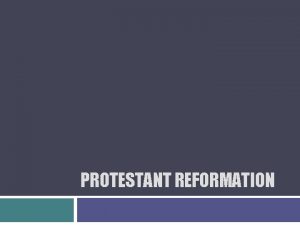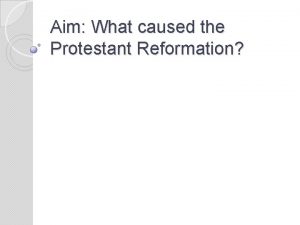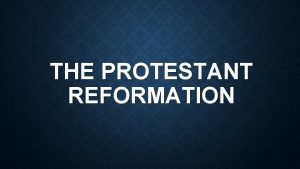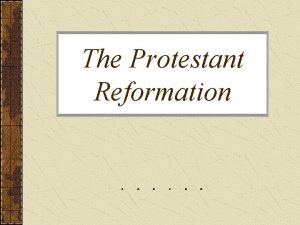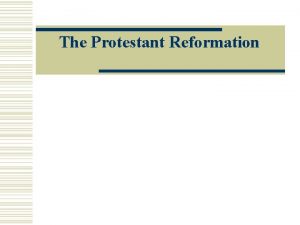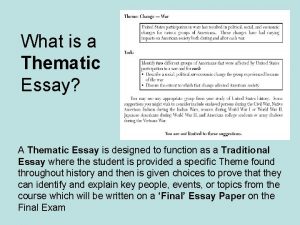Turning Points Thematic Essay Turning Point Protestant Reformation


















- Slides: 18

Turning Points Thematic Essay

Turning Point: Protestant Reformation • Description of Event: – A reform movement led by Martin Luther (a German Monk) – Attempt by Luther to reform the Catholic Church of corrupt practices. – Luther is Excommunicated and forms a separate sect of Christianity.

Events Leading Up to Event • Church CORRUPTION – Dishonest priests, too wealthy • INDULGENCES – Sold by the Church to make $$ (Johann Tetzel) • 95 THESES – Luther writes 95 things he would like the church to reform…Spark of Reformation • Luther supported by POOR, PRINCES AND MERCHANTS • PRINTING PRESS – Spreads reformation ideas quickly around Europe

How it Changed History • End of Religious Unity in Europe – (Catholics/Protestants) Religious Tension – Religious Wars (Ireland) • Decreased Power of Pope • Increased Power of Kings (King Henry-Eng) • Catholic Counter Reformation: Council of Trent – Jesuits=Catholic Missionaries (Spread Christ-America) – Inquisition= Attempt to Rid Europe of Protestants

Turning Point: Discovery of Americas (AKA-Columbian Exchange/Exploration/Encounter) • Description: – Columbus Discovers the Americas – 15 th Cent. • Searching for All Water Route to India (Spice Trade) – Europeans quickly conquer Natives (Aztec/Inca) – Establish Columbian Exchange and Triangle Trade between Europe, Africa and the Americas

Events Leading up to TP • Age of Exploration – New technology allows Europeans to Explore the World • Superior Technology – Allows the Euros to easily conquer Natives (Conquistadors) • Europeans desire Gold, God and Glory

How it Changed History • Columbian Exchange: Global Transfer of Goods/Ideas b/w Europe and “New World” – New Foods (potato) to Europe Improves Diet – Disease (smallpox) to New World – Kills Millions • Triangle Trade – Raw Materials to Europe from new World – Slaves to Americas from Africa (Middle Passage) – Guns/Finished Goods to Africa from Europe • Mercantilism – Colony exists to benefit Mother Country (Raw Materials/Markets) • Encomienda (Rigid Class Structure in New World) – Based on Birth/Blood, Provides Native/Slave Labor for Europeans – Similar to Caste System in India, Feudal System in Europe

Turning Point: Russian Revolution • Description: Poor Russian Peasants lead a Revolution against Czarist Rule in Russia – (Autocracy) or Absolute Monarchy is overthrown by a violent revolution led by BOLSHEVIKS – V. I. Lenin(leader) demands “PEACE, LAND, BREAD” – Russia becomes Communist Soviet Union

Events Leading Up to TP • GFMNP: Government of Russia Failed to Meet the Needs of the People in Russia. • Czarist Rule – Leaders live in wealth, Everyone else in Poverty • WWI – Disaster for Russia, Millions Die/Starve, Not Enough Weapons/Supplies, Stuck on “Eastern Front”

How it Changed History Russia Pulls out of WWI V. I. Lenin and Bolshevik Party Comes to Power Russia is broken up into SOVIETS Russia is forced into a civil war between nationalists and communists • Stalin becomes leader of the COMMUNISTS • Soviet Union becomes 1 st Communist Power • Leads to Cold War • •

Turning Point: Industrial Revolution • Description: An economic revolution in which Europe began a Factory System and Large Scale Manufacturing. – Begins in England: Capital, Stability, Harbors, Resources (Coal/Iron) – Capitalism

Events Leading Up to TP – Agricultural Revolution led to Surplus • New fertilizers and tools – New Inventions: Flying Shuttle, Water Frame, Steam Engine – Commercial Revolution: Development of capitalist economic system, Joint Stock Companies – Mercantilism brings large quantities of raw materials into Europe

How it Changed History • Positive Impacts – Worker Conditions Improve • Factory Act of 1833 • Child Labor Laws – – Suffrage Better Transportation Social Mobility Increased Trade/Interaction/Cultural Diffusion • Negative Impacts – – – Gap between rich and poor (CLASS TENSION) Poor working conditions – SADLER REPORT Pollution Poverty Conflicts between Nations • LED TO THE DEVELOPMENT OF COMMUNISM – A response to poor conditions experienced by the PROLETARIAT (Working Class) to overthrow the BOURGEOISIE (Owners of Means of Production)

Nationalist Leaders • Leader: Mohandas Gandhi • Nation: India • Leader: Emperor Meiji • Nation: Japan

Mohandas Gandhi/India Ideas AND Methods: Nationalism – Pride and love in one’s country Self Determination – Desire to be free of imperial rule, Rule your own nation. Civil Disobedience – Refusal to Obey Unjust Laws Non-Violent Protest – Desire to achieve goals without the use of violence Hunger Strike – Gandhi Fasts (Doesn’t Eat) to end violence between Hindus/Muslims Salt March – Gandhi leads followers on a March to Indian ocean to make Salt. Protest against British Taxes on Salt Homespun Movement – Gandhi encourages Indians to make their own clothing/textiles to avoid supporting British Industries.

Impact on their people and nation • Gandhi Achieves Indian Independence from British Colonial Rule. • India is partitioned into India for Hindus and Pakistan for Muslims. • India struggles to overcome the negative aspects of Colonial Rule. Cash crop economy doesn’t meet the needs of the people – need for GREEN REVOLUTION.

Emperor Meiji/Japan Ideas and Methods: Modernization – The Desire to become modern and technologically advanced. Westernization – Process of become more like the Industrialized West (Western Europe) Imperialism – Process by which a stronger country takes over a weaker country. Industrialization – Process by which a country builds up industries and develops a factory system. - Creates transportation network - Reforms banking, government, social classes

Impact on the People and Nation • Japan becomes a modern industrial nation • Industrialization creates a need for Raw Materials Japanese Imperialism • Japan invades Manchuria, Korea and China • Advanced transportation and communication systems. • Westernizes so they KEEP OUT THE WEST • Imperialism (Military Aggression) gets Japan involved in WWII
 Protestants vs catholic
Protestants vs catholic Chapter 16 lesson 1 the protestant reformation answer key
Chapter 16 lesson 1 the protestant reformation answer key The reformation quiz
The reformation quiz What caused the protestant reformation?
What caused the protestant reformation? Chapter 13 section 3 the protestant reformation
Chapter 13 section 3 the protestant reformation Unit 3 martin luther and the protestant reformation
Unit 3 martin luther and the protestant reformation Protestant reformation cartoon
Protestant reformation cartoon Why did the sale of indulgences become a critical issue
Why did the sale of indulgences become a critical issue Reformation ap world history
Reformation ap world history Crash course protestant reformation
Crash course protestant reformation The protestant reformation crossword puzzle
The protestant reformation crossword puzzle What factors encouraged the protestant reformation?
What factors encouraged the protestant reformation? Unit 3: martin luther & the protestant reformation
Unit 3: martin luther & the protestant reformation Protestant reformation political cartoon
Protestant reformation political cartoon Unit 12 lesson 3 the protestant reformation
Unit 12 lesson 3 the protestant reformation Protestant reformation
Protestant reformation Protestant reformation
Protestant reformation Protestant reformation map
Protestant reformation map Protestant reformation kahoot
Protestant reformation kahoot
